University of [University Name] 5EC511 Individual Client Report CW2
VerifiedAdded on 2023/01/17
|15
|2930
|33
Report
AI Summary
This individual client report analyzes a dataset of UK wood, furniture, and paper manufacturing companies. The report examines the distribution of profit rates, comparing them across different company sizes (SMEs vs. large enterprises) and export activities. It also assesses the return on capital employed (ROCE) for different company sizes and analyzes the relationship between profit rates and other quantitative variables, such as employee numbers, shareholder funds, and cost of production. The analysis utilizes descriptive statistics, correlation, chi-square tests, and ANOVA to draw conclusions about the financial performance and key drivers of profitability within the sector. The report's findings highlight the profitability of the manufacturing sector and the impact of export activities and company size on financial outcomes.

INDIVIDUAL CLIENT
REPORT
REPORT
Paraphrase This Document
Need a fresh take? Get an instant paraphrase of this document with our AI Paraphraser
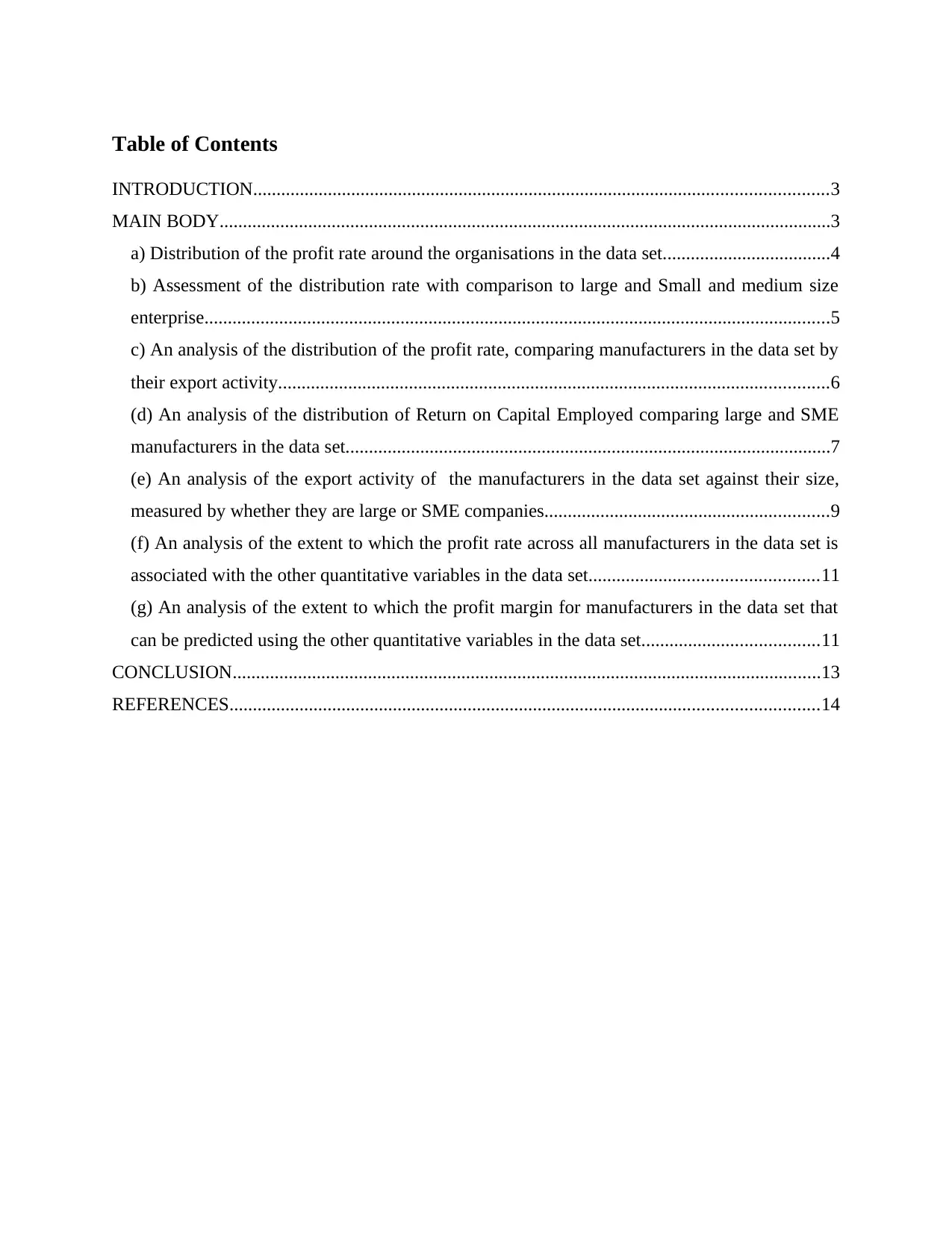
Table of Contents
INTRODUCTION...........................................................................................................................3
MAIN BODY...................................................................................................................................3
a) Distribution of the profit rate around the organisations in the data set....................................4
b) Assessment of the distribution rate with comparison to large and Small and medium size
enterprise......................................................................................................................................5
c) An analysis of the distribution of the profit rate, comparing manufacturers in the data set by
their export activity......................................................................................................................6
(d) An analysis of the distribution of Return on Capital Employed comparing large and SME
manufacturers in the data set........................................................................................................7
(e) An analysis of the export activity of the manufacturers in the data set against their size,
measured by whether they are large or SME companies.............................................................9
(f) An analysis of the extent to which the profit rate across all manufacturers in the data set is
associated with the other quantitative variables in the data set.................................................11
(g) An analysis of the extent to which the profit margin for manufacturers in the data set that
can be predicted using the other quantitative variables in the data set......................................11
CONCLUSION..............................................................................................................................13
REFERENCES..............................................................................................................................14
INTRODUCTION...........................................................................................................................3
MAIN BODY...................................................................................................................................3
a) Distribution of the profit rate around the organisations in the data set....................................4
b) Assessment of the distribution rate with comparison to large and Small and medium size
enterprise......................................................................................................................................5
c) An analysis of the distribution of the profit rate, comparing manufacturers in the data set by
their export activity......................................................................................................................6
(d) An analysis of the distribution of Return on Capital Employed comparing large and SME
manufacturers in the data set........................................................................................................7
(e) An analysis of the export activity of the manufacturers in the data set against their size,
measured by whether they are large or SME companies.............................................................9
(f) An analysis of the extent to which the profit rate across all manufacturers in the data set is
associated with the other quantitative variables in the data set.................................................11
(g) An analysis of the extent to which the profit margin for manufacturers in the data set that
can be predicted using the other quantitative variables in the data set......................................11
CONCLUSION..............................................................................................................................13
REFERENCES..............................................................................................................................14

INTRODUCTION
The term quantitative skills for business can be defined as critical analysis of behaviour
and skills of various types of quantitative data (Shieh and Jan, 2015). This shows a monetary
aspect along with various types of financial techniques and projected measures. The report
covers detailed information about analysis of statistics of business for investors who are going to
make invest in various types of industries such as wood, furniture etc. This analysis is being done
by help of evaluation of given data series of companies. Basically, the distribution of data is
being compared with production department under series of data by export activities. In addition,
the project report shows an evaluation of return on capital employed (R. O. C. E.) to small
medium enterprise and big manufacturers which is subject to data set. The profit rates from
different producers with provided data series also assessed with variable data series. Basically,
the main goal of this project report is to give a complete analysis of monetary performance of
wood, furniture and paper manufacturing sectors (Reid and Wilkes, 2016). Under the report,
different types of statistical methods are applied for computing favourable outcomes such as
descriptive analysis technique, histogram, correlation, Chi squared test by complete explanation.
These all techniques are used on the given data set to do a proper analysis.
MAIN BODY
Industry overview:
Due to uncertainties in the economics various types of challenges are raised for various
segments such as furniture, paper and wood sectors in the entire United Kingdom. Because of
Brexit, exporting cost has been raised and became a main issue for investors who are going to
invest in the furniture and manufacturing businesses (Wang, Xiong and Shi, 2016). As well as
the manufacturing sector of paper and paperboard largely relays on the certain degree on labour
uprise from European Union. In accordance of National statistics office, in year 2017, products
of petroleum has been raised by 7% of United Kingdom industrial segment. On the other hand,
European labour considered into account for about 11 % of both United Kingdom mining
sector's work force (About industry review of United Kingdom, 2019).
The term quantitative skills for business can be defined as critical analysis of behaviour
and skills of various types of quantitative data (Shieh and Jan, 2015). This shows a monetary
aspect along with various types of financial techniques and projected measures. The report
covers detailed information about analysis of statistics of business for investors who are going to
make invest in various types of industries such as wood, furniture etc. This analysis is being done
by help of evaluation of given data series of companies. Basically, the distribution of data is
being compared with production department under series of data by export activities. In addition,
the project report shows an evaluation of return on capital employed (R. O. C. E.) to small
medium enterprise and big manufacturers which is subject to data set. The profit rates from
different producers with provided data series also assessed with variable data series. Basically,
the main goal of this project report is to give a complete analysis of monetary performance of
wood, furniture and paper manufacturing sectors (Reid and Wilkes, 2016). Under the report,
different types of statistical methods are applied for computing favourable outcomes such as
descriptive analysis technique, histogram, correlation, Chi squared test by complete explanation.
These all techniques are used on the given data set to do a proper analysis.
MAIN BODY
Industry overview:
Due to uncertainties in the economics various types of challenges are raised for various
segments such as furniture, paper and wood sectors in the entire United Kingdom. Because of
Brexit, exporting cost has been raised and became a main issue for investors who are going to
invest in the furniture and manufacturing businesses (Wang, Xiong and Shi, 2016). As well as
the manufacturing sector of paper and paperboard largely relays on the certain degree on labour
uprise from European Union. In accordance of National statistics office, in year 2017, products
of petroleum has been raised by 7% of United Kingdom industrial segment. On the other hand,
European labour considered into account for about 11 % of both United Kingdom mining
sector's work force (About industry review of United Kingdom, 2019).
⊘ This is a preview!⊘
Do you want full access?
Subscribe today to unlock all pages.

Trusted by 1+ million students worldwide
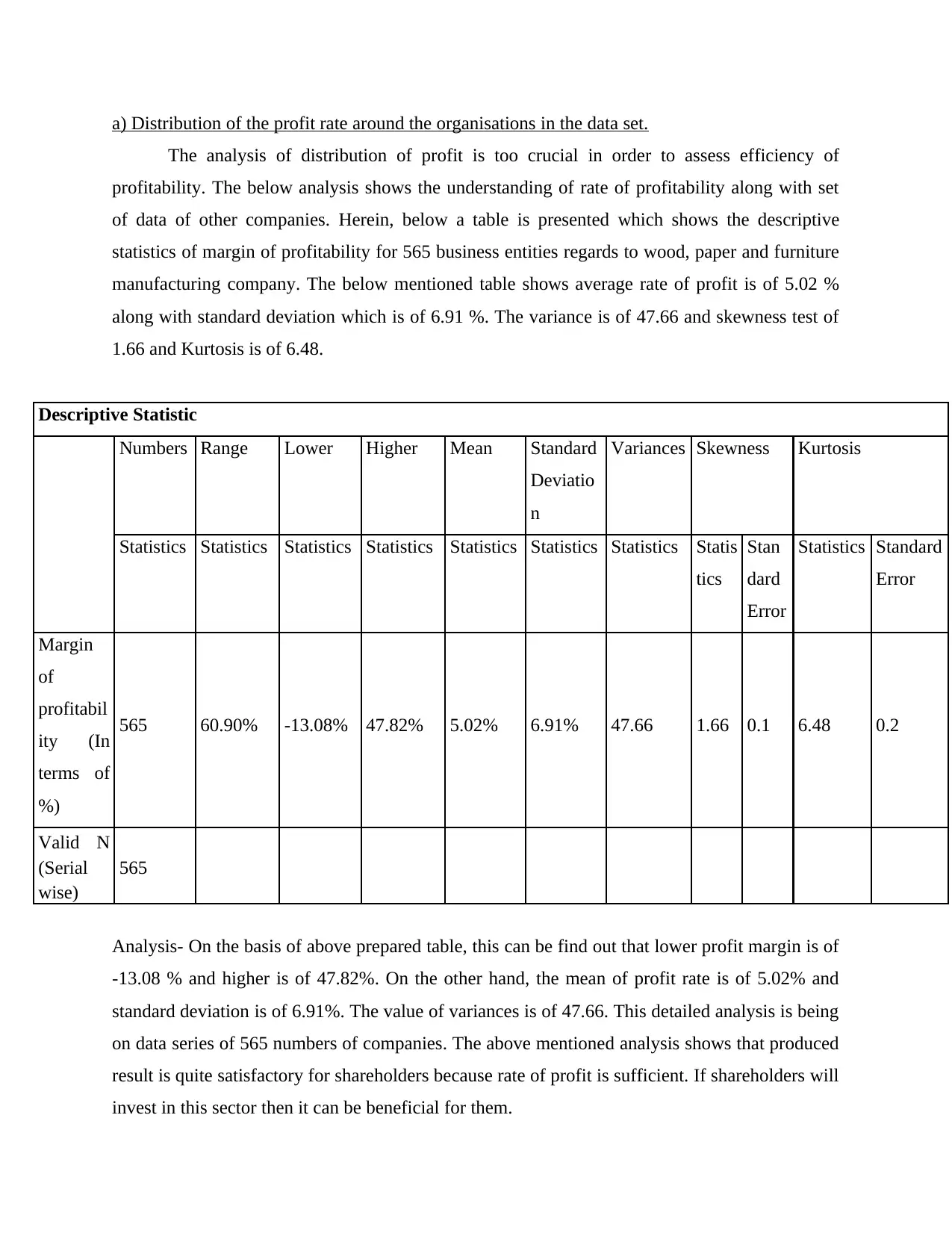
a) Distribution of the profit rate around the organisations in the data set.
The analysis of distribution of profit is too crucial in order to assess efficiency of
profitability. The below analysis shows the understanding of rate of profitability along with set
of data of other companies. Herein, below a table is presented which shows the descriptive
statistics of margin of profitability for 565 business entities regards to wood, paper and furniture
manufacturing company. The below mentioned table shows average rate of profit is of 5.02 %
along with standard deviation which is of 6.91 %. The variance is of 47.66 and skewness test of
1.66 and Kurtosis is of 6.48.
Descriptive Statistic
Numbers Range Lower Higher Mean Standard
Deviatio
n
Variances Skewness Kurtosis
Statistics Statistics Statistics Statistics Statistics Statistics Statistics Statis
tics
Stan
dard
Error
Statistics Standard
Error
Margin
of
profitabil
ity (In
terms of
%)
565 60.90% -13.08% 47.82% 5.02% 6.91% 47.66 1.66 0.1 6.48 0.2
Valid N
(Serial
wise)
565
Analysis- On the basis of above prepared table, this can be find out that lower profit margin is of
-13.08 % and higher is of 47.82%. On the other hand, the mean of profit rate is of 5.02% and
standard deviation is of 6.91%. The value of variances is of 47.66. This detailed analysis is being
on data series of 565 numbers of companies. The above mentioned analysis shows that produced
result is quite satisfactory for shareholders because rate of profit is sufficient. If shareholders will
invest in this sector then it can be beneficial for them.
The analysis of distribution of profit is too crucial in order to assess efficiency of
profitability. The below analysis shows the understanding of rate of profitability along with set
of data of other companies. Herein, below a table is presented which shows the descriptive
statistics of margin of profitability for 565 business entities regards to wood, paper and furniture
manufacturing company. The below mentioned table shows average rate of profit is of 5.02 %
along with standard deviation which is of 6.91 %. The variance is of 47.66 and skewness test of
1.66 and Kurtosis is of 6.48.
Descriptive Statistic
Numbers Range Lower Higher Mean Standard
Deviatio
n
Variances Skewness Kurtosis
Statistics Statistics Statistics Statistics Statistics Statistics Statistics Statis
tics
Stan
dard
Error
Statistics Standard
Error
Margin
of
profitabil
ity (In
terms of
%)
565 60.90% -13.08% 47.82% 5.02% 6.91% 47.66 1.66 0.1 6.48 0.2
Valid N
(Serial
wise)
565
Analysis- On the basis of above prepared table, this can be find out that lower profit margin is of
-13.08 % and higher is of 47.82%. On the other hand, the mean of profit rate is of 5.02% and
standard deviation is of 6.91%. The value of variances is of 47.66. This detailed analysis is being
on data series of 565 numbers of companies. The above mentioned analysis shows that produced
result is quite satisfactory for shareholders because rate of profit is sufficient. If shareholders will
invest in this sector then it can be beneficial for them.
Paraphrase This Document
Need a fresh take? Get an instant paraphrase of this document with our AI Paraphraser
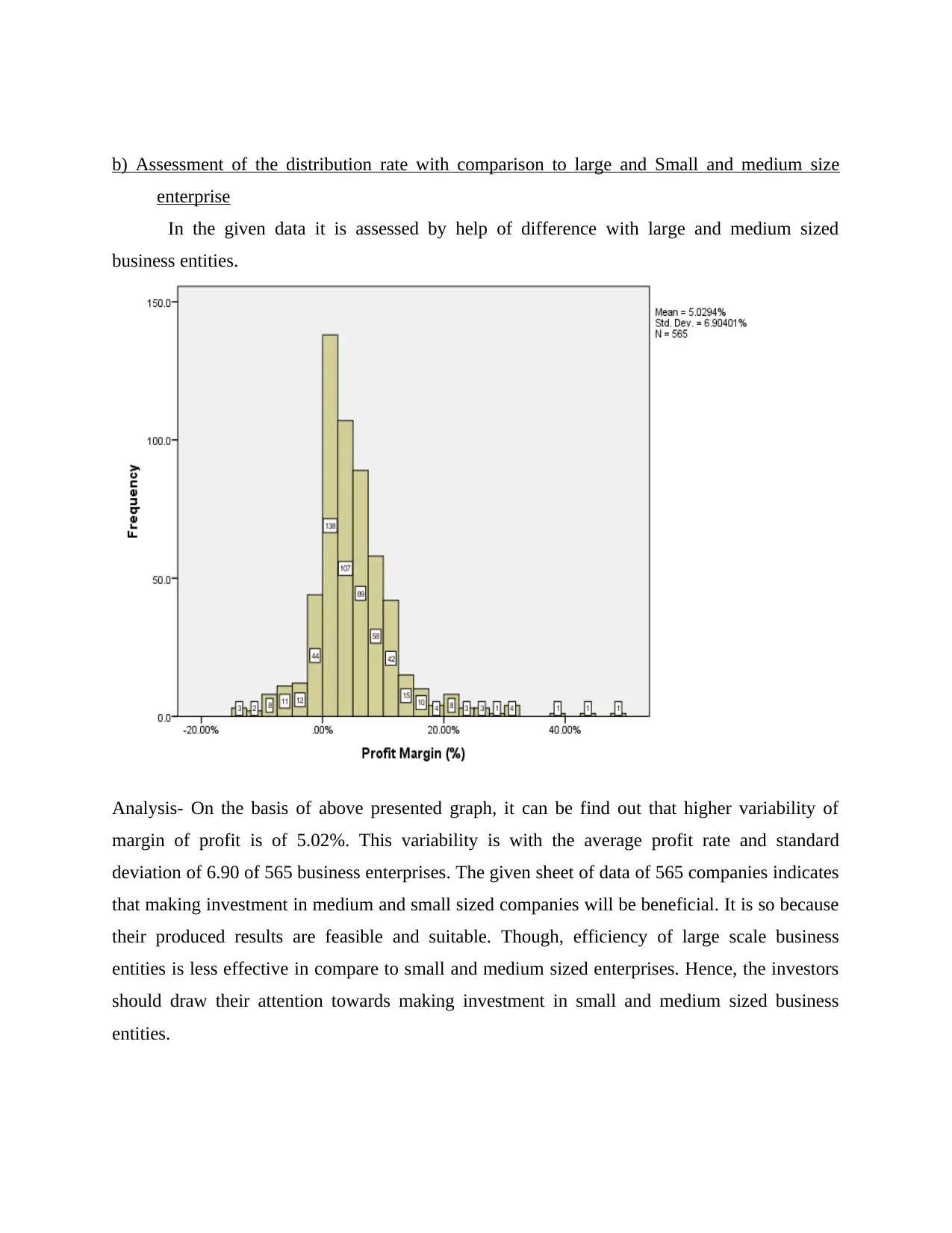
b) Assessment of the distribution rate with comparison to large and Small and medium size
enterprise
In the given data it is assessed by help of difference with large and medium sized
business entities.
Analysis- On the basis of above presented graph, it can be find out that higher variability of
margin of profit is of 5.02%. This variability is with the average profit rate and standard
deviation of 6.90 of 565 business enterprises. The given sheet of data of 565 companies indicates
that making investment in medium and small sized companies will be beneficial. It is so because
their produced results are feasible and suitable. Though, efficiency of large scale business
entities is less effective in compare to small and medium sized enterprises. Hence, the investors
should draw their attention towards making investment in small and medium sized business
entities.
enterprise
In the given data it is assessed by help of difference with large and medium sized
business entities.
Analysis- On the basis of above presented graph, it can be find out that higher variability of
margin of profit is of 5.02%. This variability is with the average profit rate and standard
deviation of 6.90 of 565 business enterprises. The given sheet of data of 565 companies indicates
that making investment in medium and small sized companies will be beneficial. It is so because
their produced results are feasible and suitable. Though, efficiency of large scale business
entities is less effective in compare to small and medium sized enterprises. Hence, the investors
should draw their attention towards making investment in small and medium sized business
entities.
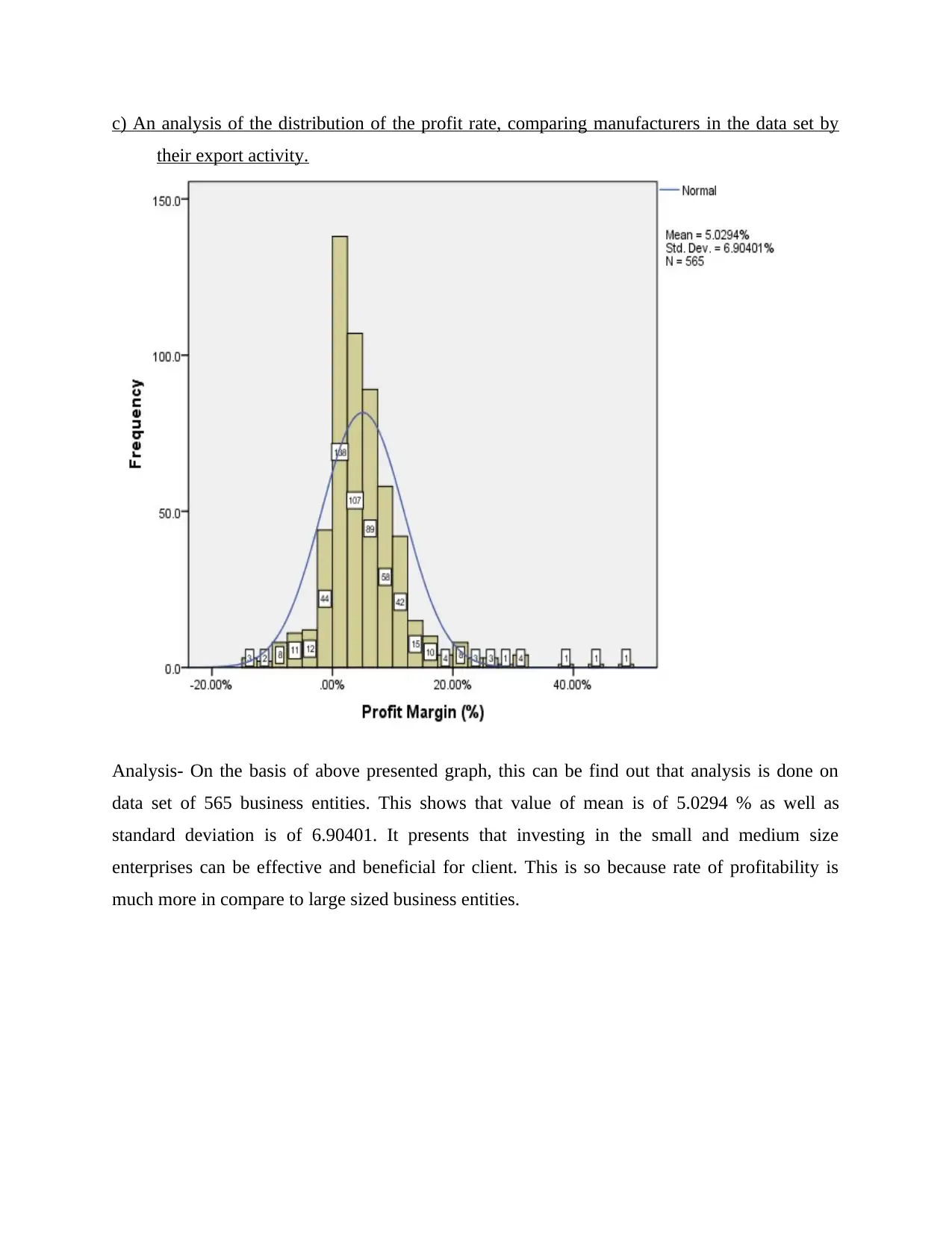
c) An analysis of the distribution of the profit rate, comparing manufacturers in the data set by
their export activity.
Analysis- On the basis of above presented graph, this can be find out that analysis is done on
data set of 565 business entities. This shows that value of mean is of 5.0294 % as well as
standard deviation is of 6.90401. It presents that investing in the small and medium size
enterprises can be effective and beneficial for client. This is so because rate of profitability is
much more in compare to large sized business entities.
their export activity.
Analysis- On the basis of above presented graph, this can be find out that analysis is done on
data set of 565 business entities. This shows that value of mean is of 5.0294 % as well as
standard deviation is of 6.90401. It presents that investing in the small and medium size
enterprises can be effective and beneficial for client. This is so because rate of profitability is
much more in compare to large sized business entities.
⊘ This is a preview!⊘
Do you want full access?
Subscribe today to unlock all pages.

Trusted by 1+ million students worldwide
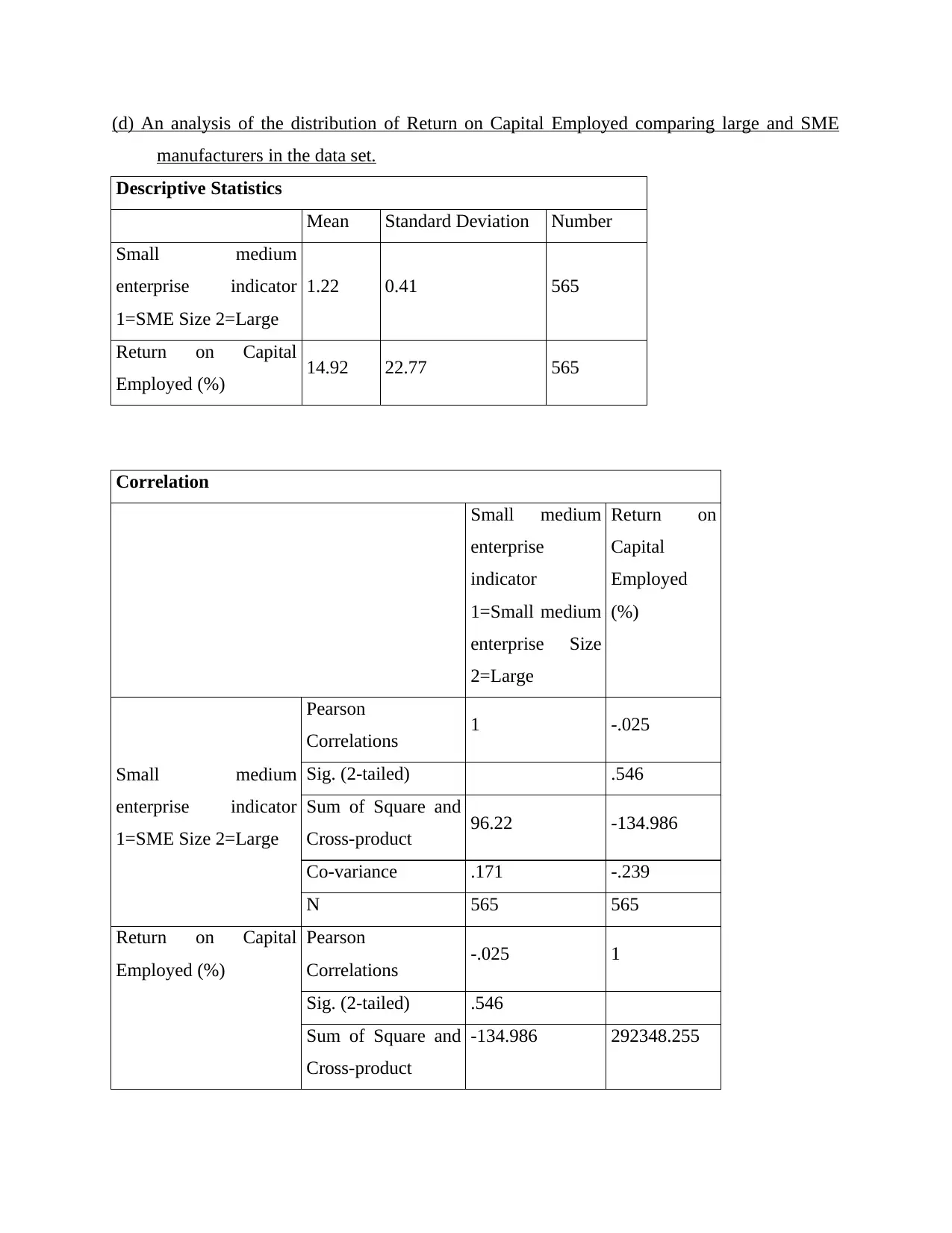
(d) An analysis of the distribution of Return on Capital Employed comparing large and SME
manufacturers in the data set.
Descriptive Statistics
Mean Standard Deviation Number
Small medium
enterprise indicator
1=SME Size 2=Large
1.22 0.41 565
Return on Capital
Employed (%) 14.92 22.77 565
Correlation
Small medium
enterprise
indicator
1=Small medium
enterprise Size
2=Large
Return on
Capital
Employed
(%)
Small medium
enterprise indicator
1=SME Size 2=Large
Pearson
Correlations 1 -.025
Sig. (2-tailed) .546
Sum of Square and
Cross-product 96.22 -134.986
Co-variance .171 -.239
N 565 565
Return on Capital
Employed (%)
Pearson
Correlations -.025 1
Sig. (2-tailed) .546
Sum of Square and
Cross-product
-134.986 292348.255
manufacturers in the data set.
Descriptive Statistics
Mean Standard Deviation Number
Small medium
enterprise indicator
1=SME Size 2=Large
1.22 0.41 565
Return on Capital
Employed (%) 14.92 22.77 565
Correlation
Small medium
enterprise
indicator
1=Small medium
enterprise Size
2=Large
Return on
Capital
Employed
(%)
Small medium
enterprise indicator
1=SME Size 2=Large
Pearson
Correlations 1 -.025
Sig. (2-tailed) .546
Sum of Square and
Cross-product 96.22 -134.986
Co-variance .171 -.239
N 565 565
Return on Capital
Employed (%)
Pearson
Correlations -.025 1
Sig. (2-tailed) .546
Sum of Square and
Cross-product
-134.986 292348.255
Paraphrase This Document
Need a fresh take? Get an instant paraphrase of this document with our AI Paraphraser
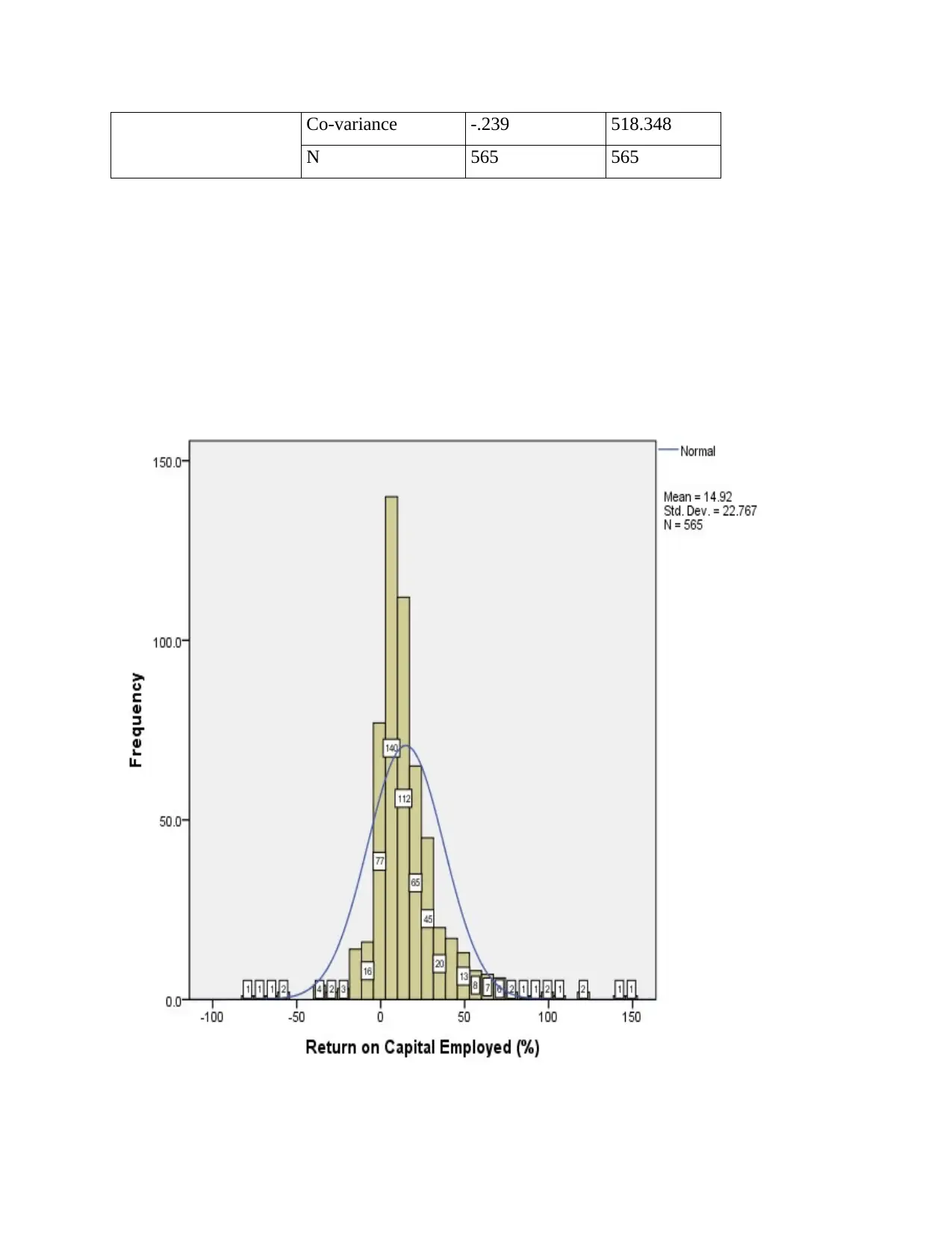
Co-variance -.239 518.348
N 565 565
N 565 565
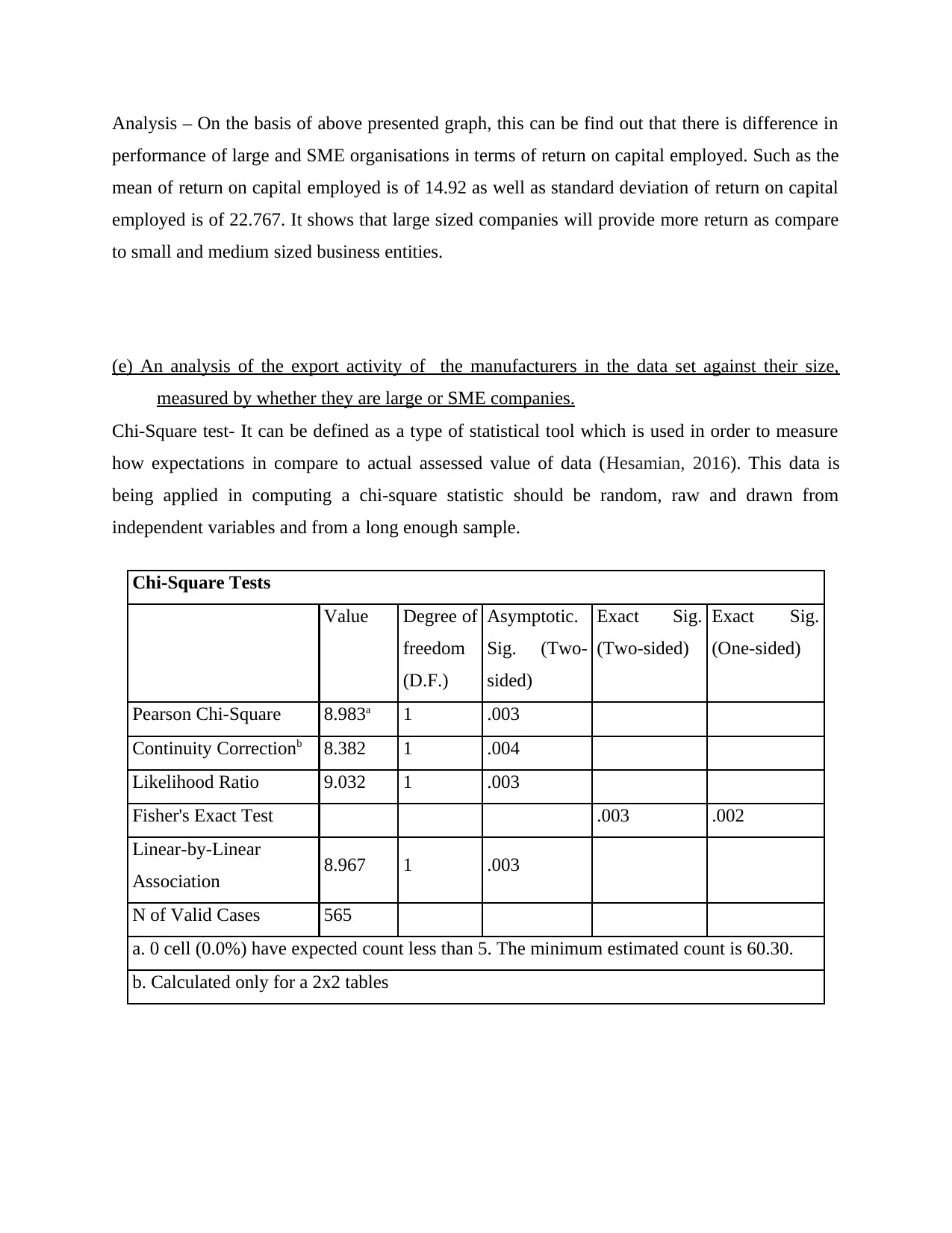
Analysis – On the basis of above presented graph, this can be find out that there is difference in
performance of large and SME organisations in terms of return on capital employed. Such as the
mean of return on capital employed is of 14.92 as well as standard deviation of return on capital
employed is of 22.767. It shows that large sized companies will provide more return as compare
to small and medium sized business entities.
(e) An analysis of the export activity of the manufacturers in the data set against their size,
measured by whether they are large or SME companies.
Chi-Square test- It can be defined as a type of statistical tool which is used in order to measure
how expectations in compare to actual assessed value of data (Hesamian, 2016). This data is
being applied in computing a chi-square statistic should be random, raw and drawn from
independent variables and from a long enough sample.
Chi-Square Tests
Value Degree of
freedom
(D.F.)
Asymptotic.
Sig. (Two-
sided)
Exact Sig.
(Two-sided)
Exact Sig.
(One-sided)
Pearson Chi-Square 8.983a 1 .003
Continuity Correctionb 8.382 1 .004
Likelihood Ratio 9.032 1 .003
Fisher's Exact Test .003 .002
Linear-by-Linear
Association 8.967 1 .003
N of Valid Cases 565
a. 0 cell (0.0%) have expected count less than 5. The minimum estimated count is 60.30.
b. Calculated only for a 2x2 tables
performance of large and SME organisations in terms of return on capital employed. Such as the
mean of return on capital employed is of 14.92 as well as standard deviation of return on capital
employed is of 22.767. It shows that large sized companies will provide more return as compare
to small and medium sized business entities.
(e) An analysis of the export activity of the manufacturers in the data set against their size,
measured by whether they are large or SME companies.
Chi-Square test- It can be defined as a type of statistical tool which is used in order to measure
how expectations in compare to actual assessed value of data (Hesamian, 2016). This data is
being applied in computing a chi-square statistic should be random, raw and drawn from
independent variables and from a long enough sample.
Chi-Square Tests
Value Degree of
freedom
(D.F.)
Asymptotic.
Sig. (Two-
sided)
Exact Sig.
(Two-sided)
Exact Sig.
(One-sided)
Pearson Chi-Square 8.983a 1 .003
Continuity Correctionb 8.382 1 .004
Likelihood Ratio 9.032 1 .003
Fisher's Exact Test .003 .002
Linear-by-Linear
Association 8.967 1 .003
N of Valid Cases 565
a. 0 cell (0.0%) have expected count less than 5. The minimum estimated count is 60.30.
b. Calculated only for a 2x2 tables
⊘ This is a preview!⊘
Do you want full access?
Subscribe today to unlock all pages.

Trusted by 1+ million students worldwide

Exporter 1 = Domestic sales only 0 = Export Sales x Small medium
sized enterprises indicator 1= Small medium sized enterprise 2=
Large Cross tabulation
Count
Small medium size
enterprises indicator
1=Small medium enterprise,
Size 2=Large
Total
1 2
Exporter 1 =
Domestic sales only 0
=Export Sales
0 202 75 277
1 240 48 288
Total 442 123 565
The above table shows information regards to data of domestic level sales and big production
entities. The data shows that domestic sales distributors are assessed of 202 and domestic
sales of export is analyzed as 240.
sized enterprises indicator 1= Small medium sized enterprise 2=
Large Cross tabulation
Count
Small medium size
enterprises indicator
1=Small medium enterprise,
Size 2=Large
Total
1 2
Exporter 1 =
Domestic sales only 0
=Export Sales
0 202 75 277
1 240 48 288
Total 442 123 565
The above table shows information regards to data of domestic level sales and big production
entities. The data shows that domestic sales distributors are assessed of 202 and domestic
sales of export is analyzed as 240.
Paraphrase This Document
Need a fresh take? Get an instant paraphrase of this document with our AI Paraphraser
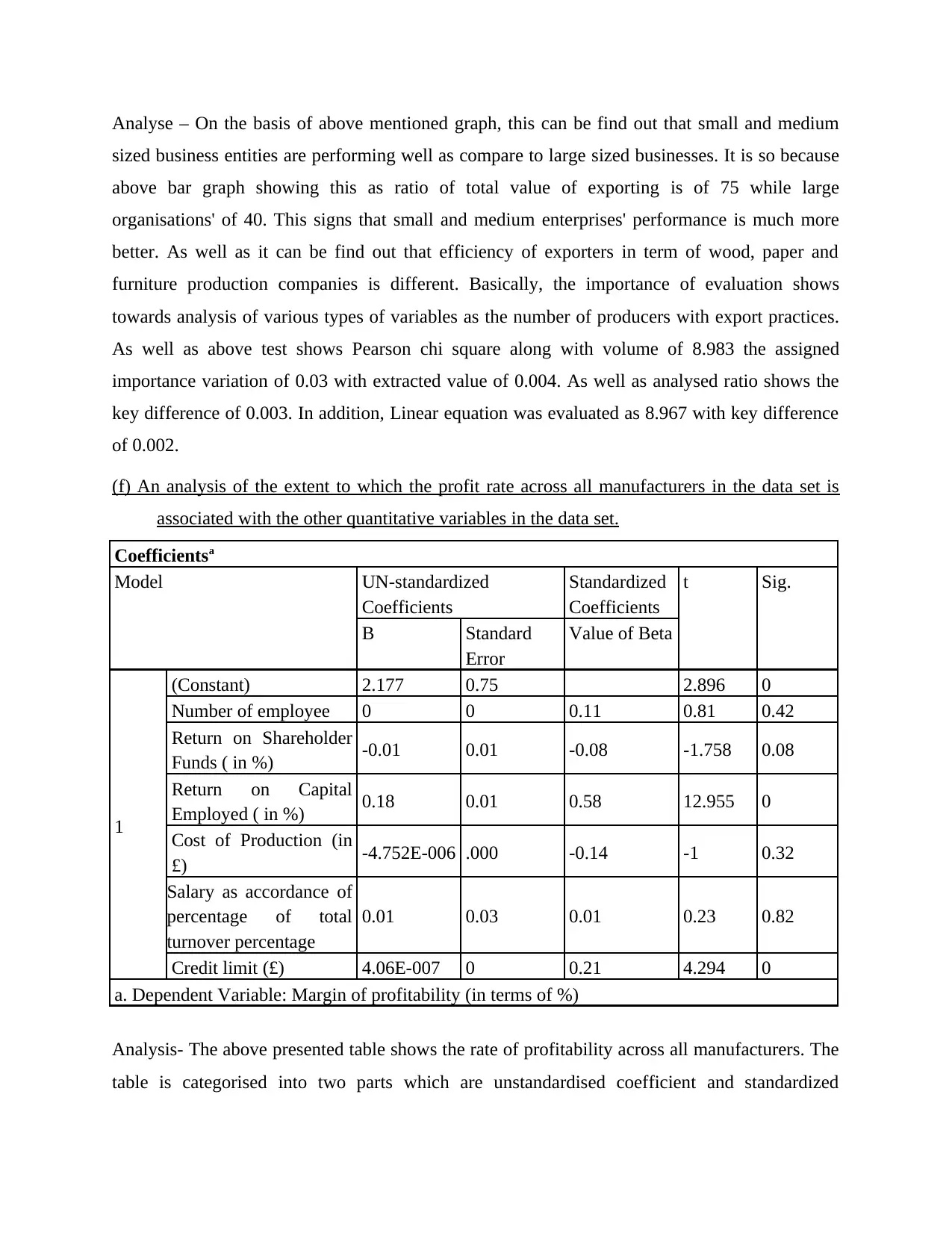
Analyse – On the basis of above mentioned graph, this can be find out that small and medium
sized business entities are performing well as compare to large sized businesses. It is so because
above bar graph showing this as ratio of total value of exporting is of 75 while large
organisations' of 40. This signs that small and medium enterprises' performance is much more
better. As well as it can be find out that efficiency of exporters in term of wood, paper and
furniture production companies is different. Basically, the importance of evaluation shows
towards analysis of various types of variables as the number of producers with export practices.
As well as above test shows Pearson chi square along with volume of 8.983 the assigned
importance variation of 0.03 with extracted value of 0.004. As well as analysed ratio shows the
key difference of 0.003. In addition, Linear equation was evaluated as 8.967 with key difference
of 0.002.
(f) An analysis of the extent to which the profit rate across all manufacturers in the data set is
associated with the other quantitative variables in the data set.
Coefficientsa
Model UN-standardized
Coefficients
Standardized
Coefficients
t Sig.
B Standard
Error
Value of Beta
1
(Constant) 2.177 0.75 2.896 0
Number of employee 0 0 0.11 0.81 0.42
Return on Shareholder
Funds ( in %) -0.01 0.01 -0.08 -1.758 0.08
Return on Capital
Employed ( in %) 0.18 0.01 0.58 12.955 0
Cost of Production (in
£) -4.752E-006 .000 -0.14 -1 0.32
Salary as accordance of
percentage of total
turnover percentage
0.01 0.03 0.01 0.23 0.82
Credit limit (£) 4.06E-007 0 0.21 4.294 0
a. Dependent Variable: Margin of profitability (in terms of %)
Analysis- The above presented table shows the rate of profitability across all manufacturers. The
table is categorised into two parts which are unstandardised coefficient and standardized
sized business entities are performing well as compare to large sized businesses. It is so because
above bar graph showing this as ratio of total value of exporting is of 75 while large
organisations' of 40. This signs that small and medium enterprises' performance is much more
better. As well as it can be find out that efficiency of exporters in term of wood, paper and
furniture production companies is different. Basically, the importance of evaluation shows
towards analysis of various types of variables as the number of producers with export practices.
As well as above test shows Pearson chi square along with volume of 8.983 the assigned
importance variation of 0.03 with extracted value of 0.004. As well as analysed ratio shows the
key difference of 0.003. In addition, Linear equation was evaluated as 8.967 with key difference
of 0.002.
(f) An analysis of the extent to which the profit rate across all manufacturers in the data set is
associated with the other quantitative variables in the data set.
Coefficientsa
Model UN-standardized
Coefficients
Standardized
Coefficients
t Sig.
B Standard
Error
Value of Beta
1
(Constant) 2.177 0.75 2.896 0
Number of employee 0 0 0.11 0.81 0.42
Return on Shareholder
Funds ( in %) -0.01 0.01 -0.08 -1.758 0.08
Return on Capital
Employed ( in %) 0.18 0.01 0.58 12.955 0
Cost of Production (in
£) -4.752E-006 .000 -0.14 -1 0.32
Salary as accordance of
percentage of total
turnover percentage
0.01 0.03 0.01 0.23 0.82
Credit limit (£) 4.06E-007 0 0.21 4.294 0
a. Dependent Variable: Margin of profitability (in terms of %)
Analysis- The above presented table shows the rate of profitability across all manufacturers. The
table is categorised into two parts which are unstandardised coefficient and standardized
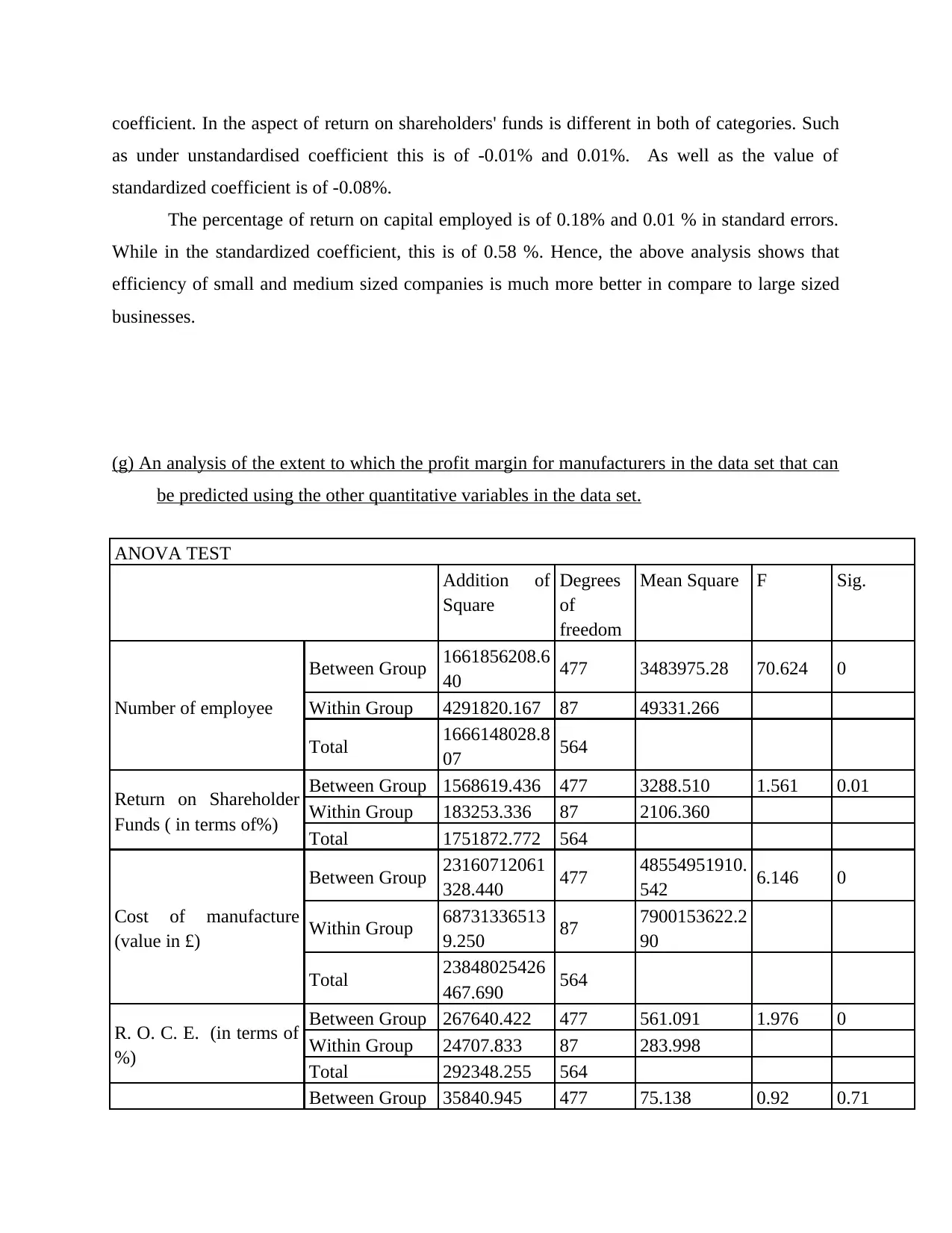
coefficient. In the aspect of return on shareholders' funds is different in both of categories. Such
as under unstandardised coefficient this is of -0.01% and 0.01%. As well as the value of
standardized coefficient is of -0.08%.
The percentage of return on capital employed is of 0.18% and 0.01 % in standard errors.
While in the standardized coefficient, this is of 0.58 %. Hence, the above analysis shows that
efficiency of small and medium sized companies is much more better in compare to large sized
businesses.
(g) An analysis of the extent to which the profit margin for manufacturers in the data set that can
be predicted using the other quantitative variables in the data set.
ANOVA TEST
Addition of
Square
Degrees
of
freedom
Mean Square F Sig.
Number of employee
Between Group 1661856208.6
40 477 3483975.28 70.624 0
Within Group 4291820.167 87 49331.266
Total 1666148028.8
07 564
Return on Shareholder
Funds ( in terms of%)
Between Group 1568619.436 477 3288.510 1.561 0.01
Within Group 183253.336 87 2106.360
Total 1751872.772 564
Cost of manufacture
(value in £)
Between Group 23160712061
328.440 477 48554951910.
542 6.146 0
Within Group 68731336513
9.250 87 7900153622.2
90
Total 23848025426
467.690 564
R. O. C. E. (in terms of
%)
Between Group 267640.422 477 561.091 1.976 0
Within Group 24707.833 87 283.998
Total 292348.255 564
Between Group 35840.945 477 75.138 0.92 0.71
as under unstandardised coefficient this is of -0.01% and 0.01%. As well as the value of
standardized coefficient is of -0.08%.
The percentage of return on capital employed is of 0.18% and 0.01 % in standard errors.
While in the standardized coefficient, this is of 0.58 %. Hence, the above analysis shows that
efficiency of small and medium sized companies is much more better in compare to large sized
businesses.
(g) An analysis of the extent to which the profit margin for manufacturers in the data set that can
be predicted using the other quantitative variables in the data set.
ANOVA TEST
Addition of
Square
Degrees
of
freedom
Mean Square F Sig.
Number of employee
Between Group 1661856208.6
40 477 3483975.28 70.624 0
Within Group 4291820.167 87 49331.266
Total 1666148028.8
07 564
Return on Shareholder
Funds ( in terms of%)
Between Group 1568619.436 477 3288.510 1.561 0.01
Within Group 183253.336 87 2106.360
Total 1751872.772 564
Cost of manufacture
(value in £)
Between Group 23160712061
328.440 477 48554951910.
542 6.146 0
Within Group 68731336513
9.250 87 7900153622.2
90
Total 23848025426
467.690 564
R. O. C. E. (in terms of
%)
Between Group 267640.422 477 561.091 1.976 0
Within Group 24707.833 87 283.998
Total 292348.255 564
Between Group 35840.945 477 75.138 0.92 0.71
⊘ This is a preview!⊘
Do you want full access?
Subscribe today to unlock all pages.

Trusted by 1+ million students worldwide
1 out of 15
Related Documents
Your All-in-One AI-Powered Toolkit for Academic Success.
+13062052269
info@desklib.com
Available 24*7 on WhatsApp / Email
![[object Object]](/_next/static/media/star-bottom.7253800d.svg)
Unlock your academic potential
Copyright © 2020–2025 A2Z Services. All Rights Reserved. Developed and managed by ZUCOL.




